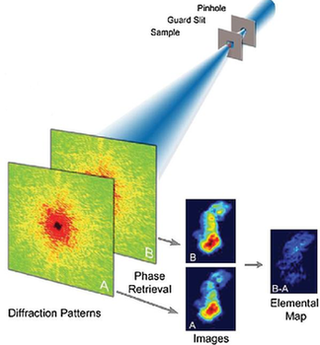January 28, 2008 feature
Microscope Sees with Nanoscale Resolution

Researchers have recently built an x-ray microscope that has a pixel resolution of just 15 nanometers, allowing scientists to study the properties of materials at the molecular scale and beyond.
The collaborative team, led by Jianwei Miao and Changyong Song from the University of California at Los Angeles, also includes researchers from the Australian Synchotron, and Argonne National Laboratory in Illinois. The ultimate resolution of the x-ray images, the scientists say, is limited only by the x-ray wavelengths, and can in principle reach the near-atomic level (the diameter of an average atom is around 0.1 nanometers). The study is published in a recent issue of Physical Review Letters.
“This is one of the highest resolutions obtained for x-ray microscopy,” Miao told PhysOrg.com. “It not only provides high-resolution images but also elemental specificity. For example, atomic spectroscopy only provides spectra, but not images.”
The imaging technique is called resonant x-ray diffraction microscopy, and this is the first demonstration of using the technique to image buried structures (such as dopants within host elements) at such a high resolution. Resonant x-ray diffraction microscopy is different than most imaging techniques because the microscope doesn’t have a lens. By avoiding the use of a lens, the method also avoids the limitations of lenses, such as a limited depth of focus that limits the thickness of the sample under investigation.
Instead of a lens, the microscope consists of a 10-micrometer-diameter pinhole that selects the most spatially coherent part of the x-ray beam, which provides the “strongest” wavelength.
The x-ray beam first takes images of two x-ray diffraction patterns of a sample: one pattern just above the sample’s absorption edge, and one just below. (The absorption edge, or band edge, occurs when incident photons obtain enough energy [binding energy] to excite the atom’s electrons and produce a photoelectron.)
Then, the researchers determined the difference between the two diffraction patterns to obtain the spatial distribution of the element. Knowing the spatial distribution enabled the researchers to determine not only the surface structure, but also the index of refraction of the sample, which can be used to determine its molecular contents.
The researchers demonstrated the technique by mapping out bismuth (Bi) dopants that are broadly dispersed and buried inside silicon (Si) atoms. In other studies, researchers have used Bi dopants to control and manipulate the physical properties of materials in order to design advanced, highly functional materials, such as in semiconductors.
Because the microscope’s CCD camera recorded thousands of diffraction patterns, the researchers developed an evolutionary algorithm to pick out the images with the best characteristics to pass on to succeeding generations and create a final spatial distribution. When analyzing the map of the Bi dopants, the researchers found that Bi atoms, which are three times larger than Si atoms, sometimes form clusters that can influence atomic growth. Insights like this may help scientists better understand the 3D self-assembly of nanostructures.
“The resonant x-ray diffraction microscope can be adapted to perform electronic orbital as well as chemical state specific imaging of a broad range of systems,” said Miao. “These include magnetic materials, semiconductors, organic materials, bio-minerals, and biological specimens.”
More information: Song, Changyoung, Bergstrom, Raymond, Ramunno-Johnson, Damien, Jiang, Huaidong, Paterson, David, Jonge, Martin D., McNulty, Ian, Lee, Jooyoung, Wang, Kang L., and Miao, Jianwei. “Nanoscale Imaging of Buried Structures with Elemental Specificity Using Resonant X-Ray Diffraction Microscopy.” Physical Review Letters 100, 025504 (2008).
Copyright 2008 PhysOrg.com.
All rights reserved. This material may not be published, broadcast, rewritten or redistributed in whole or part without the express written permission of PhysOrg.com.





















